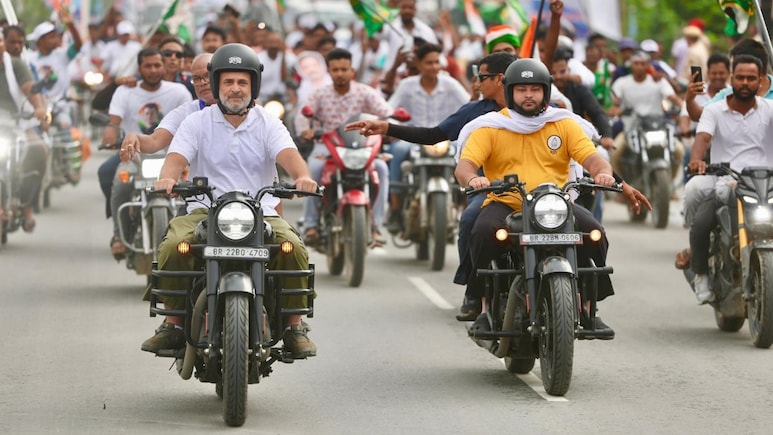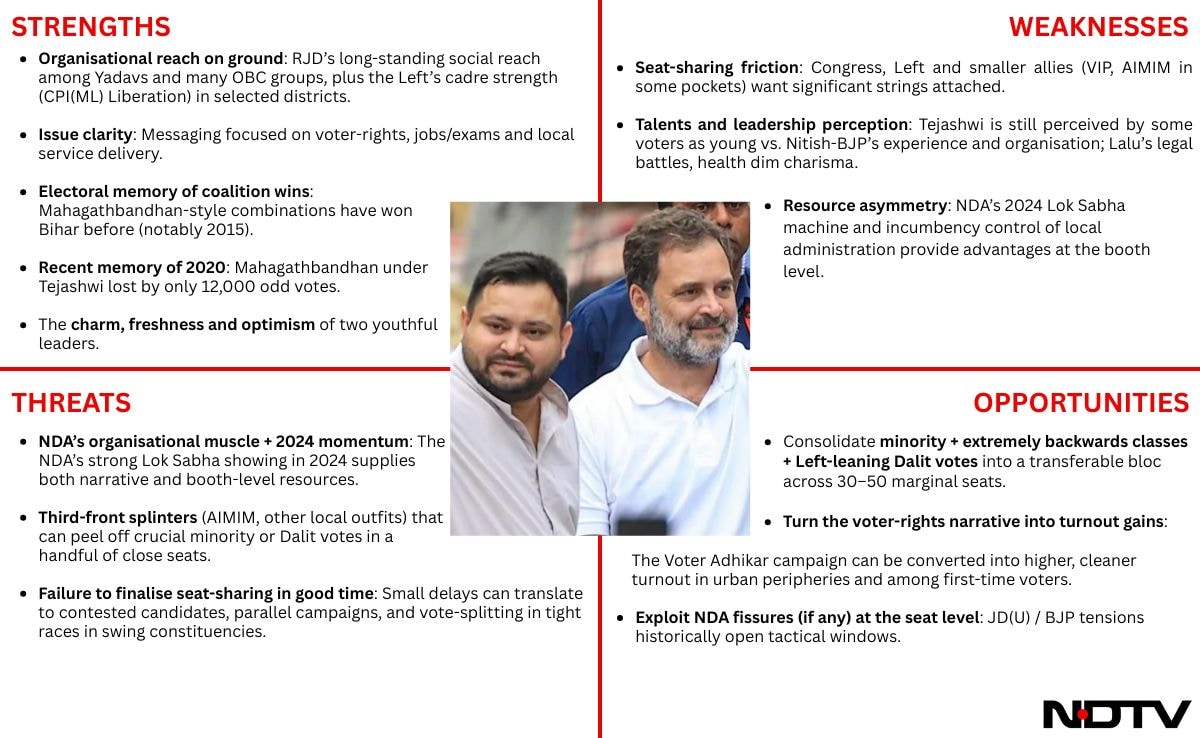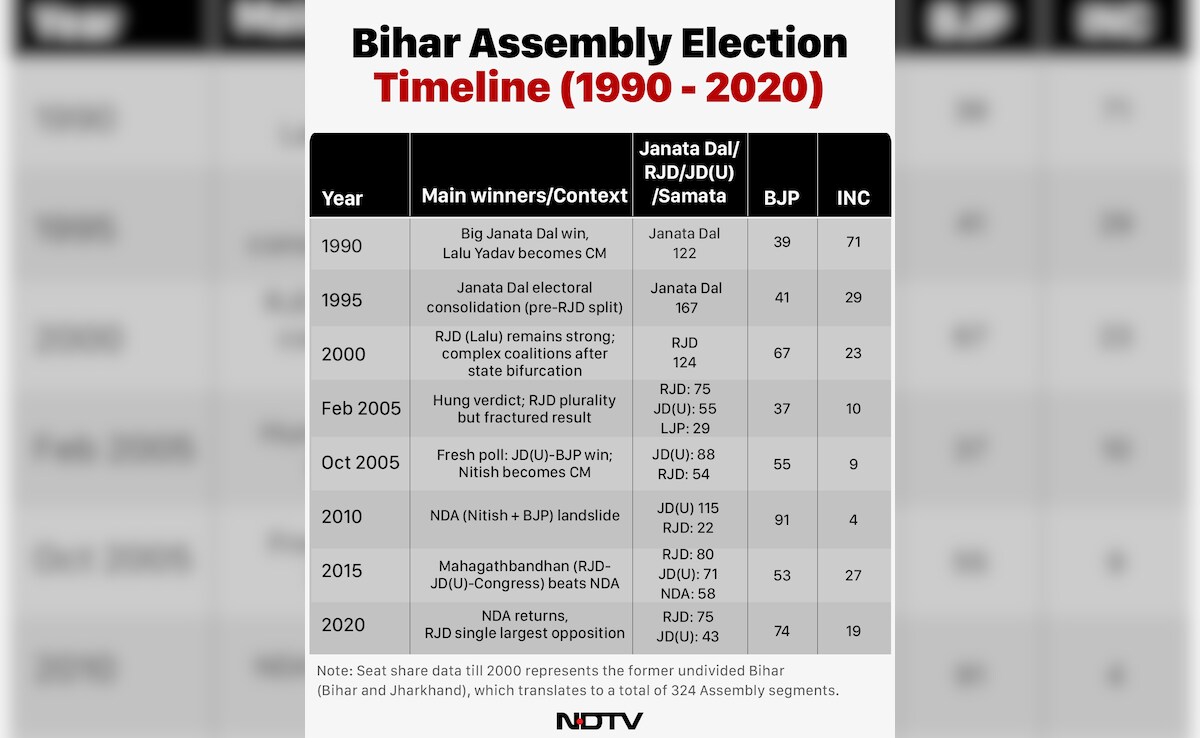
In the heat-drenched serpentine lanes of Patna, where old cinema halls still carry the names of Amitabh Bachchan and Dharmendra (Jai and Veeru), in the multi-starrer movie Sholay, and where chai-stalls are more parliament than pantry, the figure of Tejashwi Yadav cuts an oddly modern silhouette. He is young, unburdened by the gravelly voice and rustic charisma of his father, Lalu Prasad Yadav, yet still unmistakably the heir of that political legacy-a dynasty raised in the dust and dialects of Bihar. Around him, the Mahagathbandhan, that grand alliance of parties that always seems like a fragile wedding tent strung together for an unpredictable monsoon, leans on his boyish optimism like a tired elder leans on a walking stick.
The Jai And Veeru Of Bihar Politics
Beside him, more often now than not, stands Congress leader and Leader of the Opposition in Parliament Rahul Gandhi. Once dismissed as a "reluctant prince" in the Delhi drawing rooms where power is plotted, he has, over the last few years, walked India on foot, slept in the homes of farmers, and embraced the vocabulary of patience rather than privilege. In Bihar, Rahul does not stand as an outsider, but as Tejashwi's friend-his "buddy" in a state where friendships are rare commodities in politics, and where alliances are usually stitched with suspicion. The two appear as Jai and Veeru, on their motorcycles, singing "yeh dosti, hum nahi todenge...", ready to reshape the politics of Bihar in November 2025. In political slogan mongering, it is an echo of an earlier buddy-style partnership in neighbouring Uttar Pradesh in the 2017 Assembly election, as well as the 2024 Lok Sabha elections: "UP ko yeh saath pasand hai." The million-dollar question today is "Kya Bihar ko yeh saath pasand hai?"
If Lalu Yadav embodied the earthy riot of Bihar-its buffaloes and bandhs, its humor and its hunger-Tejashwi aspires to embody its future. He speaks less in barbs and more in plans, less about caste arithmetic and more about jobs, although both remain inseparably intertwined. Rahul Gandhi, in turn, provides what Tejashwi cannot yet summon: a national canopy, a lineage that stretches from Allahabad's Nehru household to Delhi's dynastic avenues. Together, they resemble two cousins at a family wedding, leaning toward each other for company, aware of their shared inheritance of both ridicule and responsibility.
The Mahagathbandhan itself is a fragile ark. It carries within it Nitish Kumar's tactical silences, the Congress's faded banners, the RJD's never-dying memory of Mandal-era power, and the Left's stubborn faith. But at its centre, increasingly, is the duo of Tejashwi and Rahul-friends in an arena of rivals, speaking the language of a generation that has grown up not with the Emergency but with the internet, not with the Mandal violence but with out-migration to Delhi, Dubai, Doha, or Darbhanga's coaching centres, producing IIT techies in droves.

When Tejashwi promises ten lakh jobs from the Patna dais, Rahul nods in approval as though remembering the many young men who walked beside him during the Bharat Jodo Yatra, carrying degrees but no salaries. When Rahul speaks of saving India's pluralism, Tejashwi offers the ground beneath it: the Bhojpuri-speaking, Bihari heartland where pluralism is not a theory but a survival mechanism.
Theirs is not a partnership of equals, nor of opposites. It is a companionship of kindred vulnerabilities. Both men are dismissed as inheritors who did not earn their place, both caricatured as inexperienced, both mocked for youth in a country that venerates grey hair. And yet, precisely because of those burdens, they can lean on one another. Rahul, who has lost too much-his grandmother, his father, his party-finds in Tejashwi the charm of a boy who still believes tomorrow can be rewritten. Tejashwi, who has inherited not just a party but the court cases and controversies that trail his father, finds in Rahul the assurance that dynasties can survive mockery and still reinvent themselves.
In Bihar, alliances are rarely about friendship; they are about necessity, arithmetic, and the instinct for survival. But in Tejashwi and Rahul, there is the glimmer of something softer: two young men, not yet fully weighed down by cynicism, imagining a state and a country that might be gentler than the one they inherited. One talks in cricket metaphors, the other in philosophical asides; one grew up in the mofussil rhythms of Patna partly schooled in DPS Vasant Vihar, the other in the cosmopolitan palaces of Delhi, schooled in St Stephen's and Harvard, but both know the experience of being jeered at in public rallies, their speeches drowned in laughter, their political legacies questioned by those who never inherited anything.
Perhaps that is what gives their alliance a different hue. Where Nitish Kumar plots and re-plots his chessboard, Tejashwi and Rahul sometimes look like two boys at a football ground, running against the odds, smiling at the improbability of it all. They are not always taken seriously, but they have learned-slowly, painfully-that ridicule can be recycled into resilience.
And in that sense, Bihar's Mahagathbandhan is more than a coalition; it is a stage on which a buddy act is being rehearsed. One that may yet falter, may yet fall apart, but also one that whispers to a weary electorate: politics need not always be about the loudest slogan or the cleverest betrayal. Sometimes, it can be about the quiet solidarity of two young men, standing side by side in a state where even survival feels like defiance.

Beyond The Buddy Act, What Is The Mahagathbandhan?
The Mahagathbandhan-the very word suggests a living quilt-has always been less a party structure than a temperament. Its fibres: RJD's vast social coalition stitched in Lalu Prasad Yadav's years; Congress's shrinking yet stubborn footprint; the Left's sinewy organisational muscle, especially CPI(ML) Liberation's cadre belts; and a flotilla of smaller parties, some steady, some migratory-today VIP of Mukesh Sahani courts a bigger share, tomorrow another acronym turns its prow to different winds. The coalition's official spine remains RJD-INC-Left; negotiations with smaller allies are a perpetual monsoon forecast.
The Old Heart Of The Story: The Lalu Era
To understand the present procession, you have to walk back to March 1990, when a young Lalu Prasad Yadav, fresh from the ferment of the JP movement, took oath as Chief Minister. He would rule-directly till 1997, and by proxy through Rabri Devi till 2005-turning the key of Bihar's politics from the old lock of upper-caste dominance to a new grammar of social justice. The fodder-scam years, indictments and convictions, the moment in July 1997 when Lalu stepped aside and Rabri Devi stepped up, all entered the state's folklore as parable and cautionary tale alike. But the social arithmetic he catalysed-Yadav-
Muslim on one axis, a broader OBC-Dalit impatience on another-remains the Mahagathbandhan's subterranean aquifer.
Mahagathbandhan Of 2015 Turfed The BJP
The next hinge swings in 2005, when Nitish Kumar, in tandem with the BJP, ends the RJD era. Ten years later, Bihar writes one of its great plot twists: the 2015 Mahagathbandhan (RJD-JD(U)-Congress) routs the BJP, with RJD the largest party. Another pivot follows in 2017, then 2022, then January 28, 2024, when Nitish returns to the NDA, again recasting the board. If Bihar has a genius, it is for choreographing alliances as seasons-arrivals that feel like returns, departures that pretend to be corrections.
The Present Tense
Today's Mahagathbandhan is RJD-led by Tejashwi Yadav-a campaigner who speaks in job numbers and roads measured in kilometres; Congress under Rahul Gandhi-whose Bihar forays have become more frequent and tactile; and the Left-with Dipankar Bhattacharya's CPI(ML) Liberation giving the alliance something rare in contemporary politics: door-to-door stamina. In 2024's Lok Sabha election, the NDA swept Bihar's tally (BJP 12, JD(U) 12, LJP(RV) 5), but the opposition still kept a toehold (RJD 4, Congress 3, CPI(ML) 2; plus 1 Independent, 1 HAM(S))-figures that, while sobering for the MGB, also underline a simple truth: Bihar often votes one way for Delhi, another for Patna.
The last Assembly scoreline (2020) is the alliance's talisman: the NDA edged a majority (125/243), but RJD finished as the single largest with 75, BJP 74, JD(U) 43, Congress 19, and the Left punching above its weight. That finish taught Tejashwi two things: that a spread-out, micro-targeted campaign can erode entrenched bastions, and that seat-sharing discipline is oxygen. Both lessons shadow today's negotiations, where the Left seeks a bigger slice, Congress wants dignity commensurate with national stature, and smaller allies demand leverage.
The Voter Adhikar Rally As A Metaphor
Seen from the highway shoulder near Buxar or Begusarai, the Voter Adhikar caravan felt less like a march to power than a pilgrimage to procedure: the insistence that the rolls be clean, that deletions be audited, that the margin between victory and despair not be decided by clerical error. Many Bihar BJP and JD(U) politicians claim: "The hurried, badly timed SIR exercise by the Election Commission has given new Oxygen and ammunition to the Mahagathabandhan today. Without the SIR, the NDA could have easily won the battle of November 2025. Now the going has become tougher, more unpreditable."
The Voter Adhikar Rally is tactical politics, to be sure, but also an ethical wager-if you can make the voter list the first battlefield, you convert cynicism into a civic task. The government's reply-dismissing it all as theatre-only sharpened the contrast: who narrates the rules, who narrates the roads. That question will be decided after the assembly elections are announced and the real campaign begins on the ground.
Coda: The Evening Light In Patna
At dusk, the Gandhi Maidan sky turns mango-gold. You can almost hear echoes: Lalu's baritone from a tape-recorder era; Sari-clad, seedha palla, shy and demure Rabri Devi waving from a jeep; Nitish at a podium with his ledger of road kilometres; and now Tejashwi, sleeves rolled, promising that governance
can be a daily verb. Rahul, in his casual white T-shirt with denim, his copy of the Constitution, his threats to the Election Commission and the baba log accent Hindi. Around them swirl the smaller parties, each with its caste archipelago, each convinced it holds the missing tile.
The Mahagathbandhan's wager in 2025 is not only to win Bihar; it is to describe it more convincingly than the other side. If the coalition can speak the language of rights (the voter list), work (jobs, exam calendars), and respect (seat bargains that feel fair), the river may yet change course by November. If not, the monsoon will pass, the river will return to its old bed, and Bihar will remind us-gently, inexorably-that in this state, alliances are weather, and weather, as every farmer knows, rewards those who read the wind early.
Track Latest News Live on NDTV.com and get news updates from India and around the world

